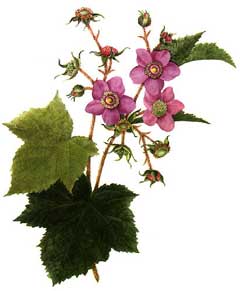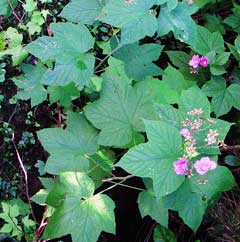 |
|
http://commons.wikimedia.org/wiki/File:Rubus_odoratus,_by_Mary_Vaux_Walcott.jpg |
 |
| http://commons.wikimedia.org/wiki/User:$Mathe94$ |
Translate this page:
Summary
Physical Characteristics

 Rubus odoratus is a deciduous Shrub growing to 2.5 m (8ft) by 2.5 m (8ft) at a medium rate.
Rubus odoratus is a deciduous Shrub growing to 2.5 m (8ft) by 2.5 m (8ft) at a medium rate.
See above for USDA hardiness. It is hardy to UK zone 3 and is not frost tender. It is in flower from June to September, and the seeds ripen from July to September. The species is hermaphrodite (has both male and female organs) and is pollinated by Bees.
Suitable for: light (sandy), medium (loamy) and heavy (clay) soils and prefers well-drained soil. Suitable pH: mildly acid, neutral and basic (mildly alkaline) soils. It can grow in semi-shade (light woodland) or no shade. It prefers moist soil.
UK Hardiness Map
US Hardiness Map
Synonyms
Plant Habitats
Woodland Garden Sunny Edge; Dappled Shade; Ground Cover;
Edible Uses
Edible Parts: Fruit
Edible Uses:
Fruit - raw or cooked[105, 161, 257]. Somewhat tart and dry[2], it is usually cooked and used in pies, jellies, preserves etc[183]. The fruit can be dried for later use[257]. This species rarely fruits well in Britain, probably due to our cooler summers[11].
References More on Edible Uses
Medicinal Uses
Plants For A Future can not take any responsibility for any adverse effects from the use of plants. Always seek advice from a professional before using a plant medicinally.
Astringent Diuretic Dysentery Kidney Odontalgic Salve Stomachic
The leaves are highly astringent[207]. They are used in the treatment of dysentery and diarrhoea[238]. The leaves have been used as a wash for old and foul sores, boils etc[257]. A decoction or infusion of the branches has been used to settle the stomach[257]. A decoction of the leaves and stems has been used to treat kidney complaints[257]. The root is astringent. A decoction of the root or the root bark has been used as a treatment for diarrhoea and colds[257]. The root has been used in the treatment of toothaches[257]. The berries have been used as a diuretic[257].
References More on Medicinal Uses
The Bookshop: Edible Plant Books
Our Latest books on Perennial Plants For Food Forests and Permaculture Gardens in paperback or digital formats.

Edible Tropical Plants
Food Forest Plants for Hotter Conditions: 250+ Plants For Tropical Food Forests & Permaculture Gardens.
More

Edible Temperate Plants
Plants for Your Food Forest: 500 Plants for Temperate Food Forests & Permaculture Gardens.
More

More Books
PFAF have eight books available in paperback and digital formats. Browse the shop for more information.
Shop Now
Other Uses
Dye
A purple to dull blue dye is obtained from the fruit[168]. Plants are very vigorous and can be grown as a tall ground cover for large areas[208].
Special Uses
Food Forest Ground cover Scented Plants
References More on Other Uses
Cultivation details
Easily grown in a good well-drained loamy soil in sun or semi-shade[1, 11, 200]. Grows well in a sandy soil but does not like clay[182]. Prefers a semi-shaded position. Does well in a woodland garden though it is less likely to fruit well in such a position. A very ornamental plant[1], it is hardy to about -30°c[184]. The glandular hairs on the stems have a powerful resinous scent somewhat like cedarwood[245]. A vigorous suckering shrub, it has perennial stems without prickles[200]. Plants in this genus are notably susceptible to honey fungus[200]. The plant is heat tolerant in zones 7 through 1. (Plant Hardiness Zones show how well plants withstand cold winter temperatures.
Plant Heat Zones show when plants would start suffering from the heat.
The Plant Heat Zone map is based on the number of "heat days" experienced in a given area where the temperature climbs to over 86 degrees F (30°C).
At this temperature, many plants begin to suffer physiological damage. Heat Zones range from 1 (no heat days) to 12 (210 or more heat days).
For example Heat Zone. 11-1 indicates that the plant is heat tolerant in zones 11 through 1.) For polyculture design as well as the above-ground architecture (form - tree, shrub etc. and size shown above) information on the habit and root pattern is also useful and given here if available. The plant growth habit is multistemmed with multiple stems from the crown [1-2]. The root pattern is suckering with new plants from underground runners away from the plant [1-2].
References Carbon Farming Information and Carbon Sequestration Information
Temperature Converter
Type a value in the Celsius field to convert the value to Fahrenheit:
Fahrenheit:
The PFAF Bookshop
Plants For A Future have a number of books available in paperback and digital form. Book titles include Edible Plants, Edible Perennials, Edible Trees,Edible Shrubs, Woodland Gardening, and Temperate Food Forest Plants. Our new book is Food Forest Plants For Hotter Conditions (Tropical and Sub-Tropical).
Shop Now
Plant Propagation
Seed - requires stratification, is best sown in early autumn in a cold frame. Sow stored seed as early as possible in the year in a cold frame and stratify for a month at 3°c if sowing later than February. Prick out the seedlings when they are large enough to handle and grow on in a cold frame. Plant them out into their permanent positions in late spring of the following year. Tip layering in July. Plant out in autumn. Division in early spring.
Other Names
If available other names are mentioned here
Flowering raspberry, Thimbleberry, Rose-flowering raspberry,
Native Range
NORTHERN AMERICA: Canada, Québec (south), Nova Scotia, Ontario, United States, Connecticut, Indiana, Maine, Massachusetts, Michigan (east), New Hampshire, New Jersey, New York, Ohio, Pennsylvania, Rhode Island, Vermont, West Virginia, Illinois (north), Georgia, Kentucky, Maryland, North Carolina (west), Tennessee, Virginia,
Weed Potential
Right plant wrong place. We are currently updating this section.
Please note that a plant may be invasive in one area but may not in your area so it's worth checking.
Conservation Status
IUCN Red List of Threatened Plants Status :

Growth: S = slow M = medium F = fast. Soil: L = light (sandy) M = medium H = heavy (clay). pH: A = acid N = neutral B = basic (alkaline). Shade: F = full shade S = semi-shade N = no shade. Moisture: D = dry M = Moist We = wet Wa = water.
Now available:
Food Forest Plants for Mediterranean Conditions
350+ Perennial Plants For Mediterranean and Drier Food Forests and Permaculture Gardens.
[Paperback and eBook]
This is the third in Plants For A Future's series of plant guides for food forests tailored to
specific climate zones. Following volumes on temperate and tropical ecosystems, this book focuses
on species suited to Mediterranean conditions—regions with hot, dry summers and cool, wet winters,
often facing the added challenge of climate change.
Read More
Expert comment
Author
L.
Botanical References
1143200
Links / References
For a list of references used on this page please go here
Readers comment